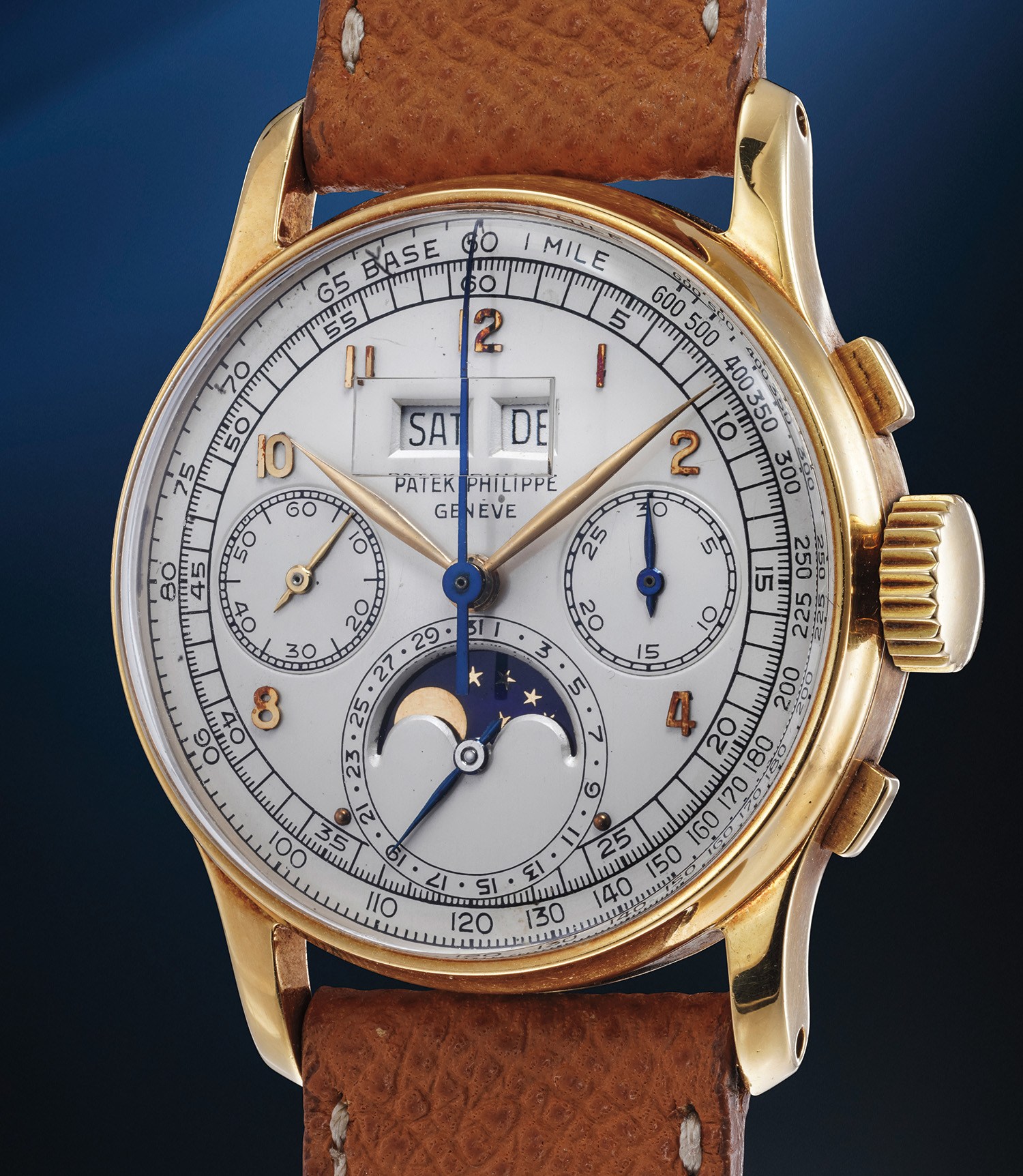
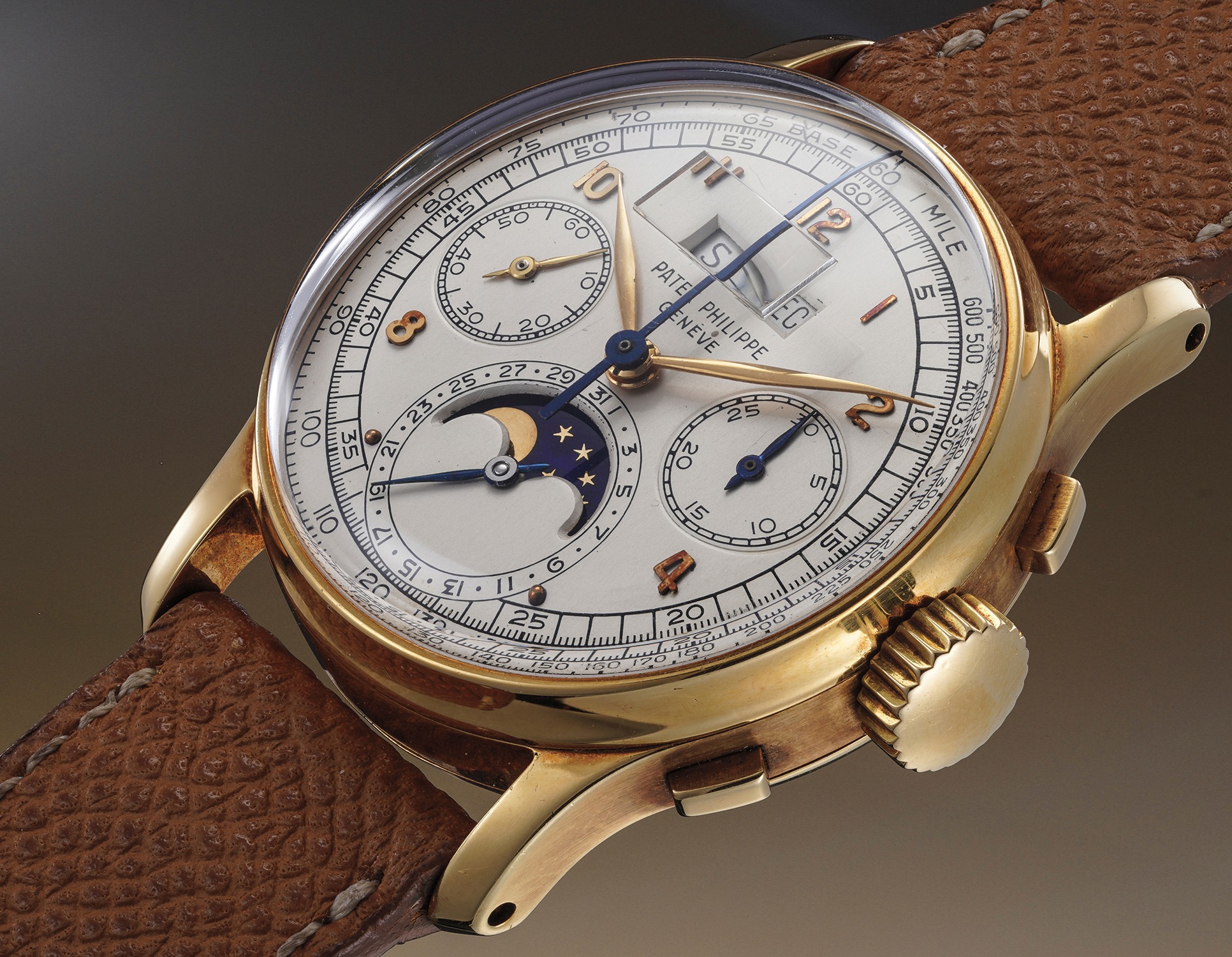
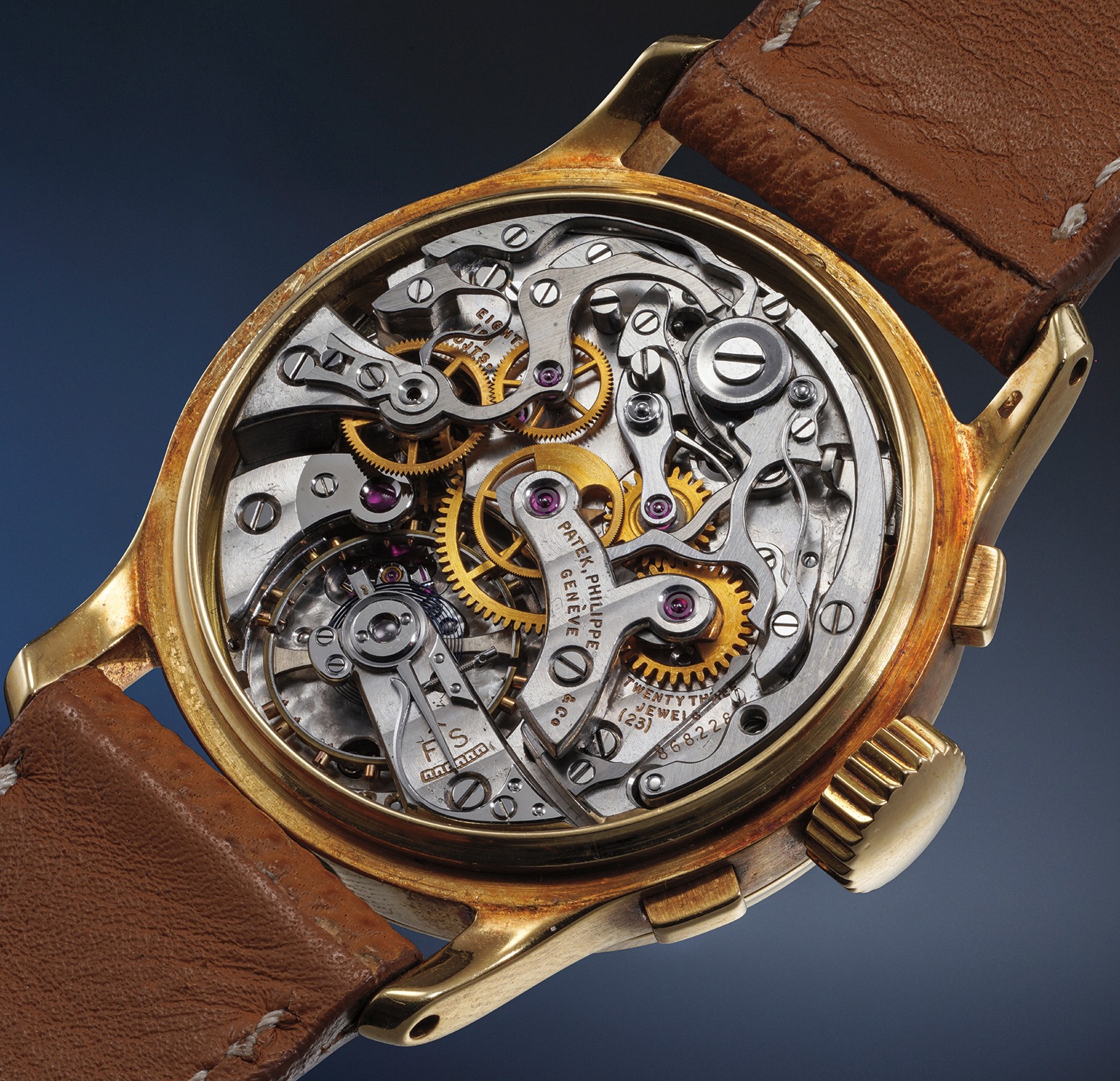
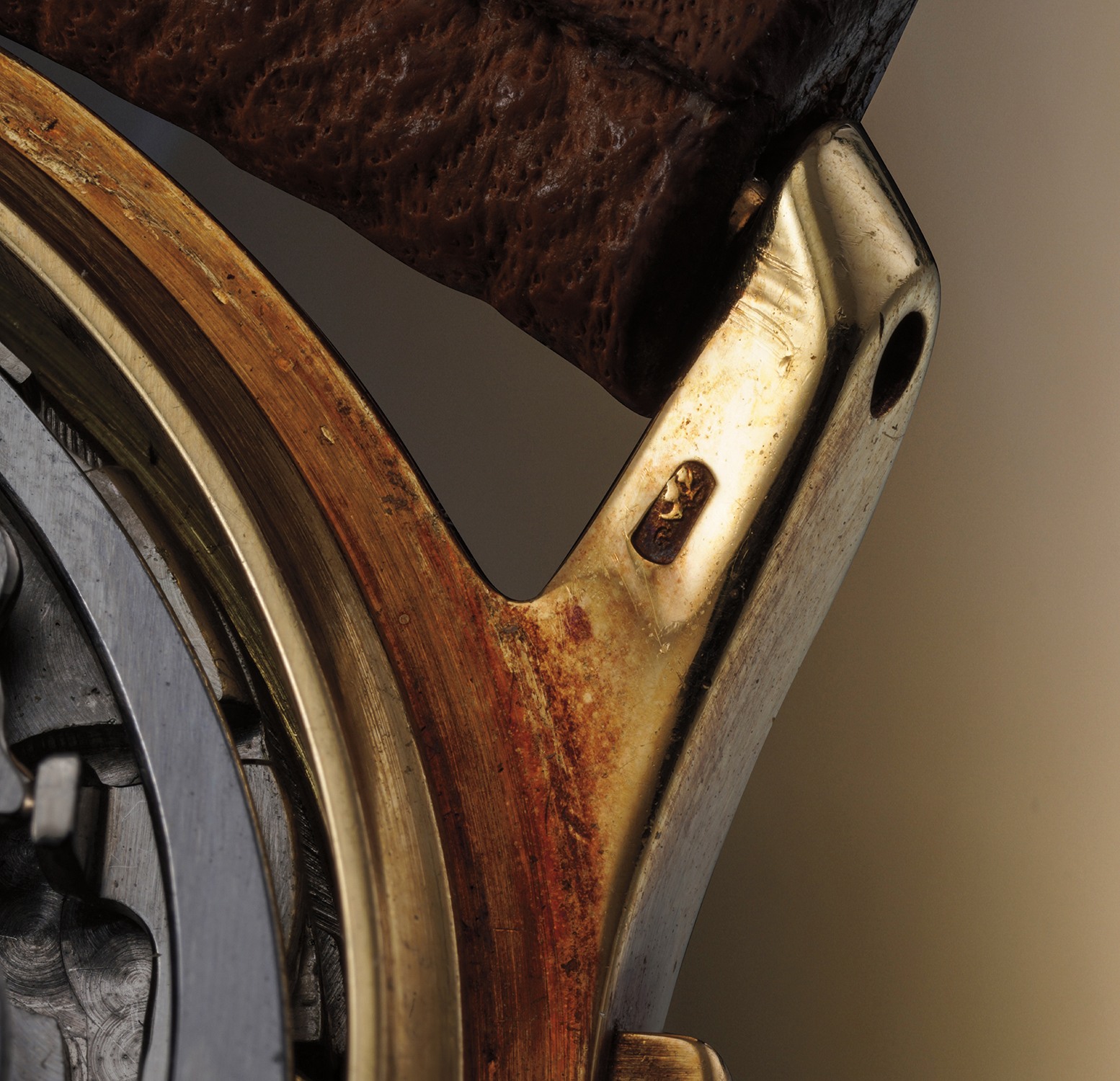
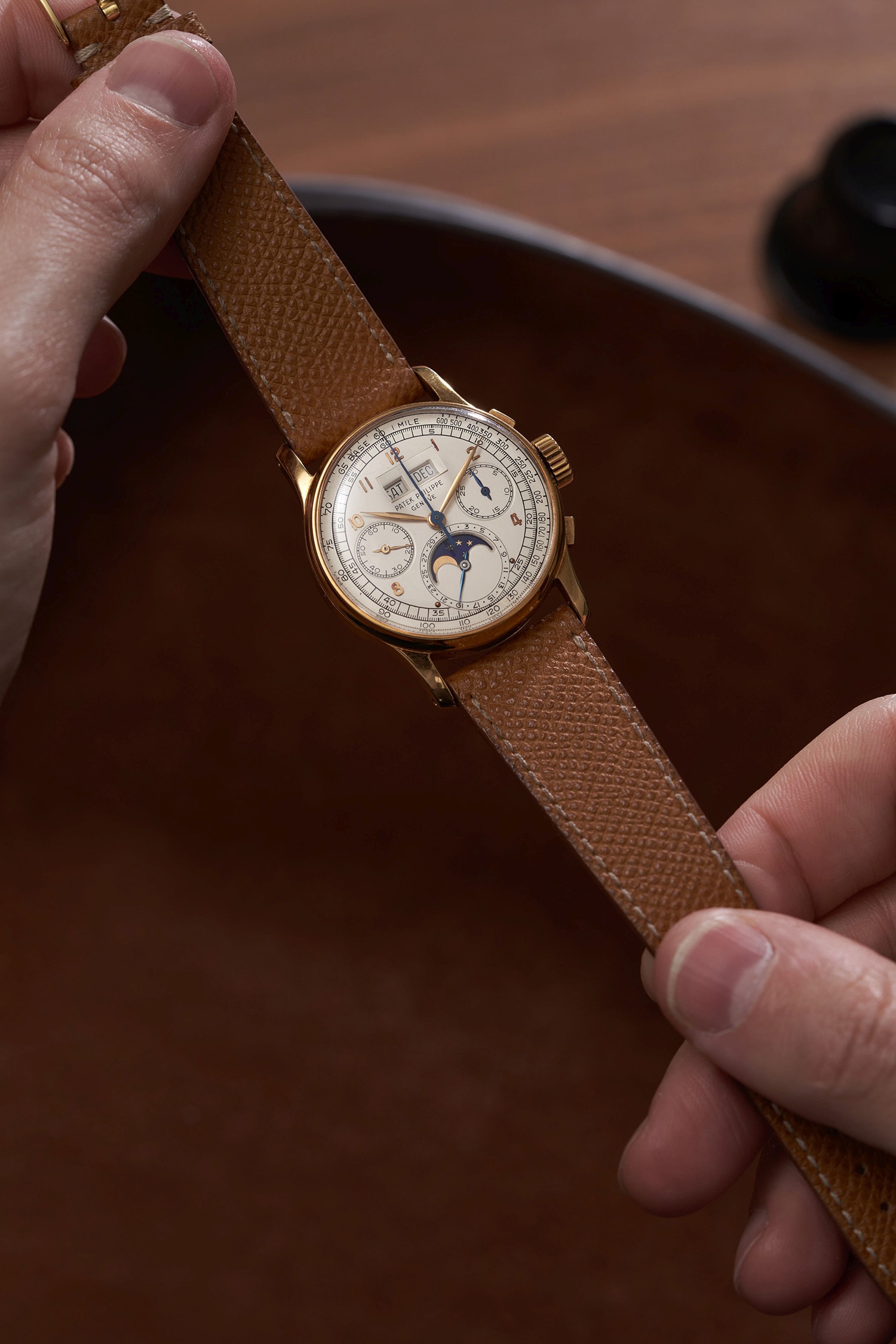
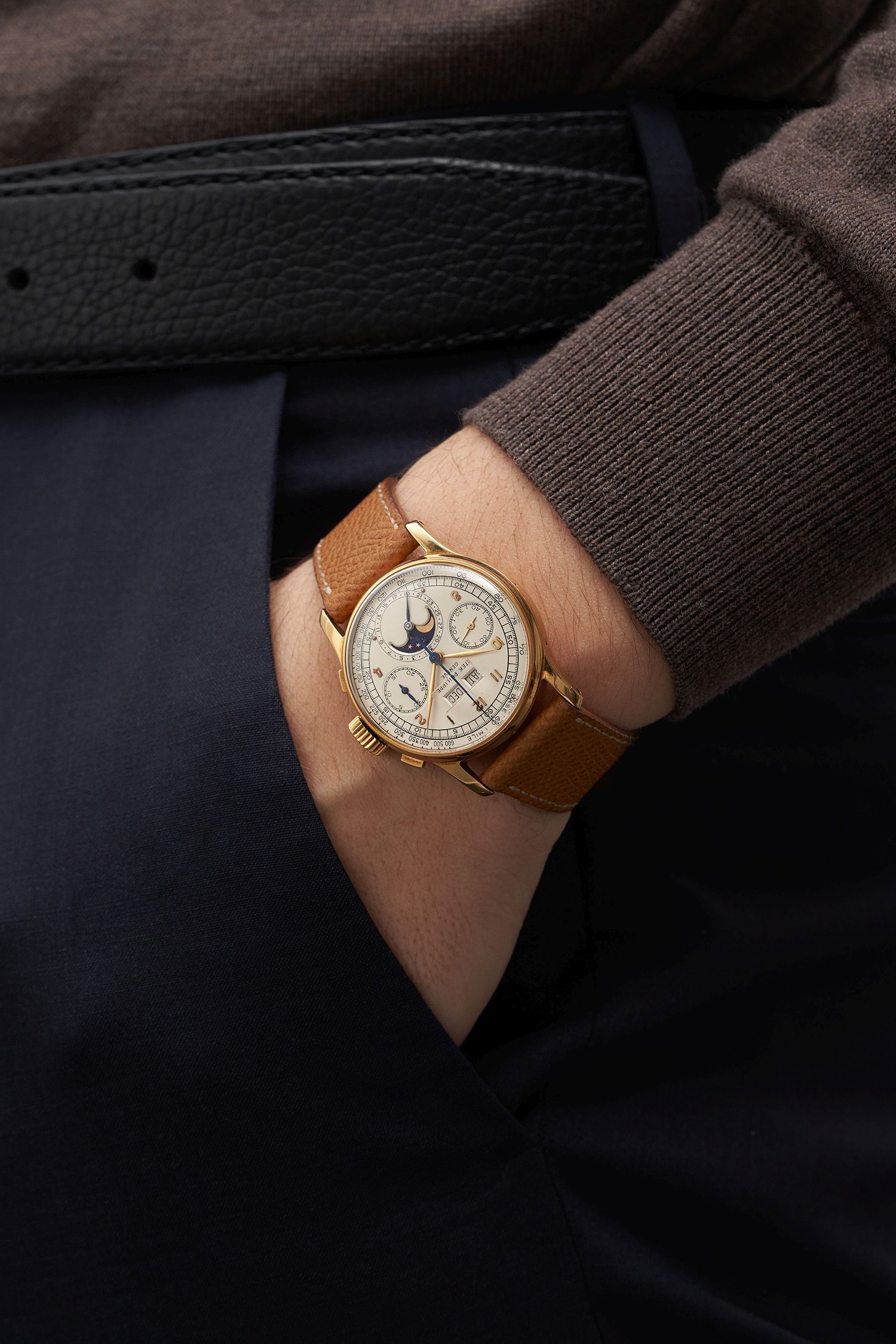






103
Patek Philippe
Ref. 1518
A superb, very scarce and incredibly sought-after yellow gold perpetual calendar chronograph wristwatch with moonphases
- Estimate
- CHF400,000 - 800,000€416,000 - 833,000$457,000 - 914,000
CHF533,400
Lot Details
- Manufacturer
- Patek Philippe
- Year
- Circa 1950
- Reference No
- 1518
- Movement No
- 868'228
- Case No
- 674'140
- Material
- 18K yellow gold
- Calibre
- manual, cal. 13''', 23 jewels
- Bracelet/Strap
- Leather
- Clasp/Buckle
- 18K yellow gold Audemars Piguet pin buckle
- Dimensions
- 35mm Diameter
- Signed
- Case, dial and movement signed
- Accessories
- Accompanied by Patek Philippe Extract from the Archives confirming production of the present watch in 1951 with applied gold hour markers and its subsequent sale on July 13, 1953
Specialist
Full-Cataloguing
Catalogue Essay
Truly an archetypal model, reference 1518 was the first perpetual calendar (with moonphases) chronograph wristwatch ever produced in series when it was launched in 1941, in the midst of World War II - a bold timing to say the least. According to research, only 281 examples were manufactured, in yellow and pink gold and a few examples in stainless steel, until the reference ceased production in the early 1950s. Not only did it set the design elements used by Patek Philippe in all of its subsequent perpetual calendar chronograph wristwatches down to today’s ref. 5270, but in its own manner greatly contributed to the manufacturer's dominant position in the watchmaking industry. Consider for example that no other company achieved a serial production of similarly complicated pieces until the 1980s. Its successors are references 2499, 3970, 5970 and finally 5270, which features an in-house movement - this make the present line of watches the only one with ongoing production at Patek Philippe since the 1940s.
Over its course of production, the ref. 1518 can be broken up to specific batches that were manufactured over the years.
It is estimated that:
1941 – 1942 = 18 examples made
1943 – 1944 = 36 examples made
1945 – 1946 = 36 examples made
1947 – 1948 = 60 examples made
1949 – 1950 = 56 examples made
1951 – 1953 = 75 examples made
Out of the 281 examples of the reference manufactured, it is believed that 215 examples were encased in yellow gold with 58 examples made in pink gold and 4 known in steel.
It features a 35mm diameter Calatrava-style, Bauhaus-inspired case. Gold cases were made by master casemaker Emile Vichet identifiable via key no. 9. The case architecture slightly changes from early (1941 – 1945) to later (1946 – 1953) examples: early cases feature a flatter appearance with a smaller crown and the positioning of the pushers was slightly higher. Later examples of the reference had lugs that were slightly more tapered, the crown is larger and the chronographic pushers sit lower. Usually with a silvered dial with applied gold Arabic and dotted numerals, the dials were manufactured by Stern Frères featuring engraved/enamelled graphics and an enamelled gold moonphases disc.
The present example is a stunning representative of this legendary reference. Boasting absolutely unmolested and vibrant graphics - without losses or fading - the dial furthermore sports very sharp edges to the day/month windows and moon phase aperture.
The case is in highly appealing condition, sporting thick and balanced lugs with the the two hallmarks not only visible but very crisp and deep, one stamped on the band and the other beneath the lug.
This remarkable specimen has been missing from the public market for about 20 years, as it was last sold in Geneva in June 2003. Its first appearance goes however back more than 20 additional years, to 1979 in New York. It would not be surprising if collectors had to once again wait a similar timespan before this piece appears for a third time.
Given the increase of public interest in these early masterpieces of watchmaking, acquiring such a remarkable specimen is destined to become an ever harder endeavour, thus rendering this one an unmissable opportunity for the serious watch collector.
Over its course of production, the ref. 1518 can be broken up to specific batches that were manufactured over the years.
It is estimated that:
1941 – 1942 = 18 examples made
1943 – 1944 = 36 examples made
1945 – 1946 = 36 examples made
1947 – 1948 = 60 examples made
1949 – 1950 = 56 examples made
1951 – 1953 = 75 examples made
Out of the 281 examples of the reference manufactured, it is believed that 215 examples were encased in yellow gold with 58 examples made in pink gold and 4 known in steel.
It features a 35mm diameter Calatrava-style, Bauhaus-inspired case. Gold cases were made by master casemaker Emile Vichet identifiable via key no. 9. The case architecture slightly changes from early (1941 – 1945) to later (1946 – 1953) examples: early cases feature a flatter appearance with a smaller crown and the positioning of the pushers was slightly higher. Later examples of the reference had lugs that were slightly more tapered, the crown is larger and the chronographic pushers sit lower. Usually with a silvered dial with applied gold Arabic and dotted numerals, the dials were manufactured by Stern Frères featuring engraved/enamelled graphics and an enamelled gold moonphases disc.
The present example is a stunning representative of this legendary reference. Boasting absolutely unmolested and vibrant graphics - without losses or fading - the dial furthermore sports very sharp edges to the day/month windows and moon phase aperture.
The case is in highly appealing condition, sporting thick and balanced lugs with the the two hallmarks not only visible but very crisp and deep, one stamped on the band and the other beneath the lug.
This remarkable specimen has been missing from the public market for about 20 years, as it was last sold in Geneva in June 2003. Its first appearance goes however back more than 20 additional years, to 1979 in New York. It would not be surprising if collectors had to once again wait a similar timespan before this piece appears for a third time.
Given the increase of public interest in these early masterpieces of watchmaking, acquiring such a remarkable specimen is destined to become an ever harder endeavour, thus rendering this one an unmissable opportunity for the serious watch collector.
Patek Philippe
Swiss | 1839Since its founding in 1839, this famous Geneva-based firm has been surprising its clientele with superbly crafted timepieces fitted with watchmaking's most prestigious complications. Traditional and conservative designs are found across Patek Philippe's watches made throughout their history — the utmost in understated elegance.Well-known for the Graves Supercomplication — a highly complicated pocket watch that was the world’s most complicated watch for 50 years — this family-owned brand has earned a reputation of excellence around the world. Patek's complicated vintage watches hold the highest number of world records for results achieved at auction compared with any other brand. For collectors, key models include the reference 1518, the world's first serially produced perpetual calendar chronograph, and its successor, the reference 2499. Other famous models include perpetual calendars such as the ref. 1526, ref. 3448 and 3450, chronographs such as the reference 130, 530 and 1463, as well as reference 1436 and 1563 split seconds chronographs. Patek is also well-known for their classically styled, time-only "Calatrava" dress watches, and the "Nautilus," an iconic luxury sports watch first introduced in 1976 as the reference 3700 that is still in production today.
Browse Maker